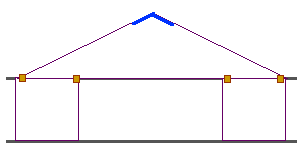
Return to Kite Menu
|
Winged Box
This is a simple variation on a standard box kite. When
first viewing a box kite, many do not perceive it as a
flying apparatus. This reaction is probably due to the fact
that it is shaped unlike our normal "flight" paradigm of
bird or airplane. Box kites do have one very important
flying advantage over many other kites: increased potential
surface area. The more area that can catch wind, the more
likely that a gentle breeze will lift it off the ground.
|

Materials for each Winged Box kite
- a ruler, a yardstick (maybe a protractor
or a compass too)
- two or more sheets of 20" x 30" tissue
paper (other colored scraps may come in handy as well if you like
streamers and cut out graphics)
- six 1/8" dowel rods: Four cut to to 32",
two cut to 25" in length
- one piece of 22" x 28" poster board if
making several kites from one pattern or newsprint if making only
one
- a pair of scissors
- transparent and strapping
tape
- white craft glue
- string
The pattern for this kite is built on two basic shapes:
- The first is a rectangle 30" long by 7" tall. Two of these
should be cut from tissue. Cut out decorations can be made on
these prior to kite construction.

Once cut, both should be sectioned off with a pencil into four
equal panels and a half inch flap on the end.
- The second is an isosceles triangle with a base of 30" and a
height of 7 1/4".

Four of these are necessary to complete this design.

Lay out the two rectangles and glue four 32" dowels along the
measured divisions. A single thin bead of glue on each dowel should
be sufficient.

An inch of dowel should protrude beyond the tissue paper.

When dried, the final flap should be glued over the opposite end
of each rectangle to form continuous loops of each.

Attach the triangles to each of the dowels with transparent
tape.

Reinforce the ends of the triangles with strapping tape.

Using Strapping tape, attach two 25" dowels diagonally to the ends
of opposite triangles through the space between the four central
dowels.

With the crossing dowels in place, the kite will support itself in
three dimensions.


Attach a string to the end of one of the cross dowels by punching
a hole through the strapping tape and tying the string to the
dowel.

|Return
to top of page|














